Y10 Physics End of Year
1/319
Earn XP
Description and Tags
Name | Mastery | Learn | Test | Matching | Spaced |
|---|
No study sessions yet.
320 Terms
what is a scalar quantity
has a magnitude but no direction
what is a vector quantity
has both magnitude and direction
the 5 scalar quantities
speed
distance
mass
time
energy
the 6 vector quantities
velocity
displacement
weight
force
acceleration
momentum
velocity definition
speed in a stated direction
equation for speed
speed (m/s) = distance (m)
time (s)
what does a straight line mean on a distance/time graph
constant speed
what does the slope of the line represent on a distance/time graph
the magnitude of the speed:
steep slope = large speed
shallow slope = small speed
flat slope = stationary (not moving)
what do curves mean on distance/time graphs
changing speed
if the slope is increasing the speed is increasing
if the slope is decreasing the speed is decreasing
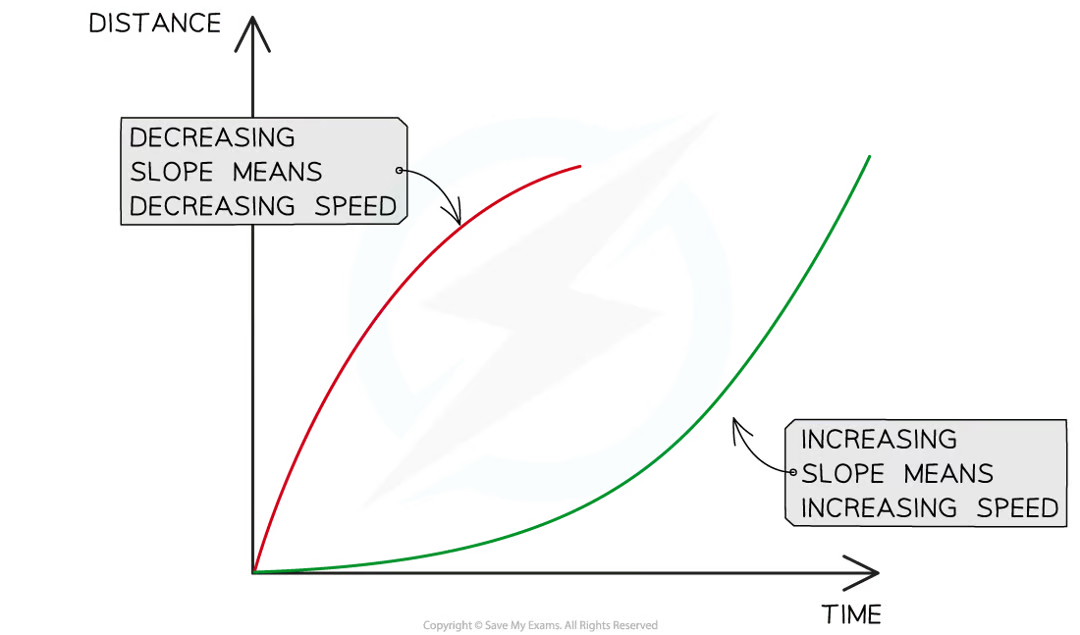
how do you work out speed from a distance/time graph
using the gradient of the line:
speed = gradient = rise / run
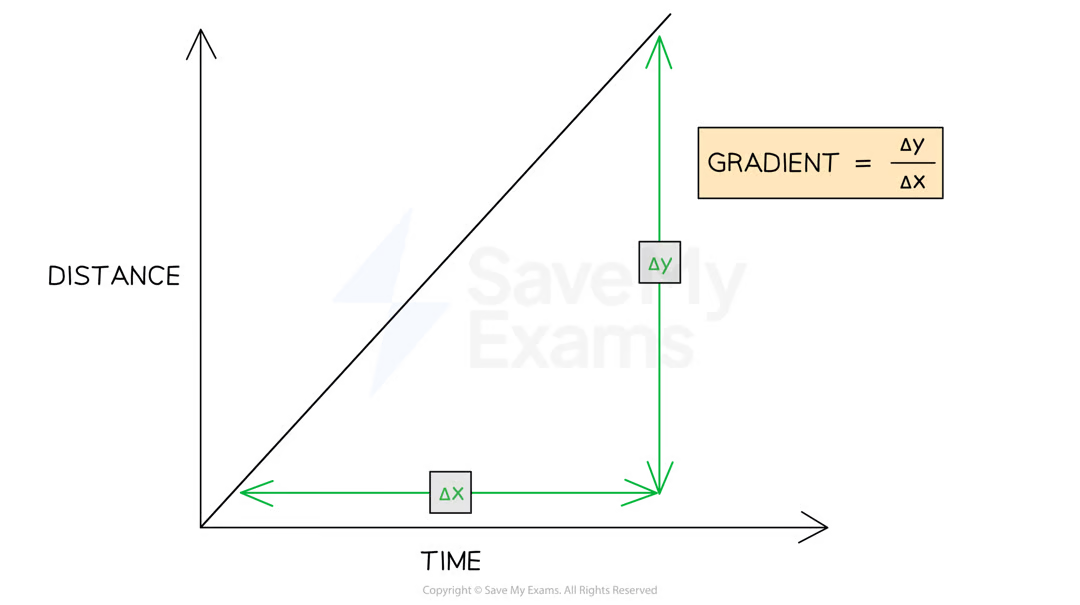
equation of acceleration
acceleration (m/s2) = change in velocity (m/s) / time taken (s)
a = v-u
t
equation for change in velocity using acceleration and distance
final velocity2 - initial velocity2 = 2 x acceleration x distance
v2 - u2 = 2ax
what does a straight line mean on a velocity/time graph
constant acceleration - the object is speeding up at a constant rate
what does the slope of the line represent on a velocity/time graph
the magnitude of acceleration
steep slope = large acceleration (speed changes quickly)
gentle slope = small acceleration (speed changes gradually)
flat line = zero acceleration (object is at a constant velocity)
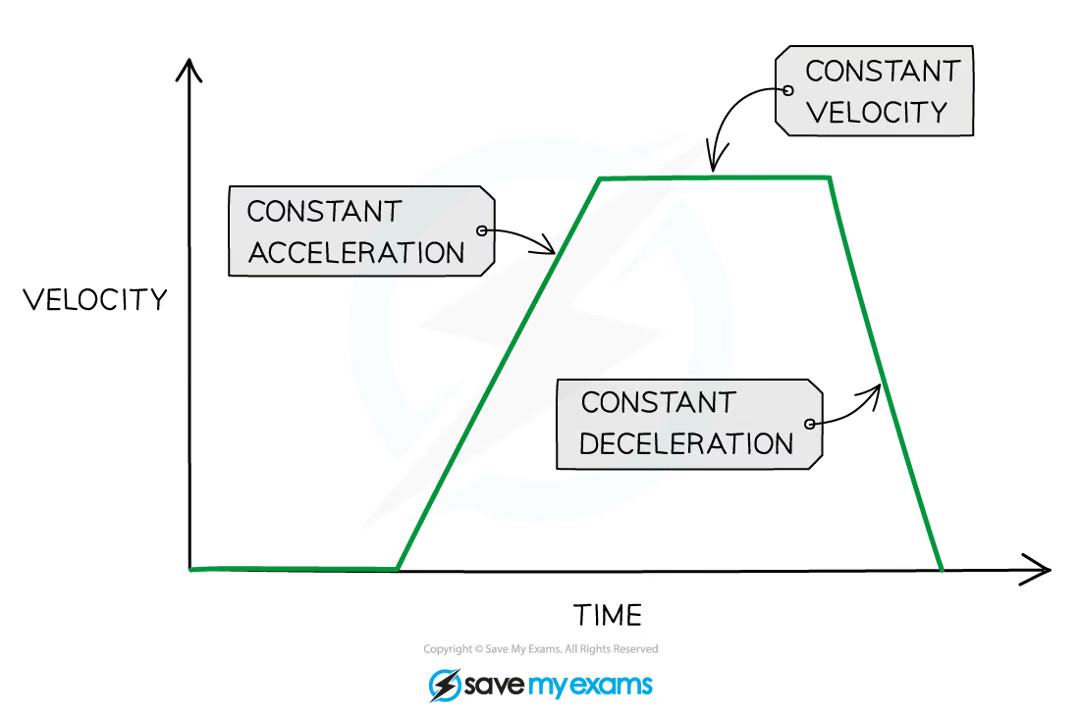
how do you calculate acceleration from a velocity/time graph
acceleration = gradient = rise / run
what does the area under a velocity/time graph represent
the displacement - the distance travelled by the object
split the area up into triangles and rectangles to work it out
what are light gates
pieces of digital equipment that accurately measure times. using it you can accurately work out speed
using 2 light gates to measure time
the moving object will block the beam of light on the light gate when it passes through, triggering the equipment
a timer will start when the object passes through the light gate
the timer is stopped when the object passes through the second light gate
the time can then be used to work out speed
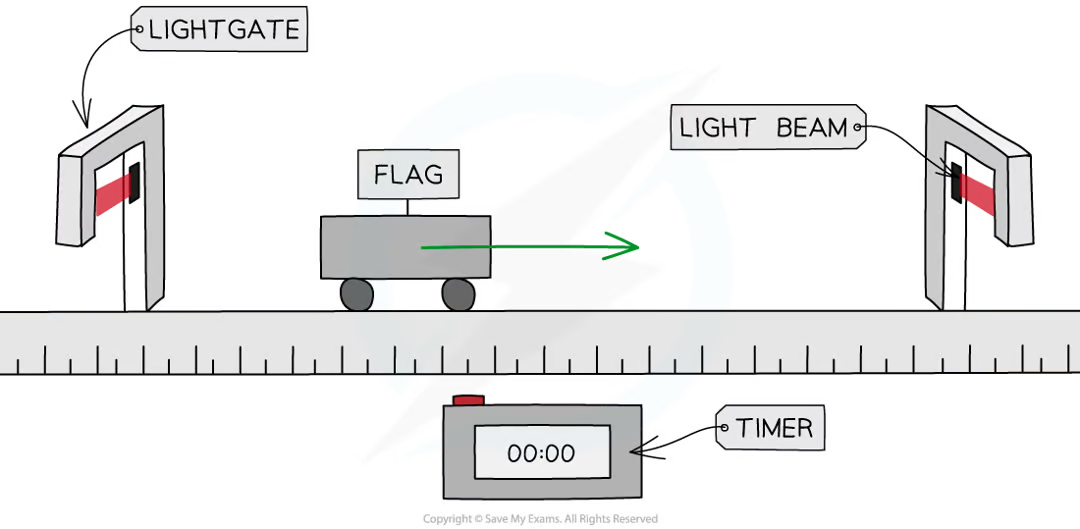
using a single light gate to measure speed
there is a flag/object on top of the moving object
as the object passes through the light gate it blocks the beam of light for a set amount of time as it passes through
the timer measures how long the light is blocked for
the distance is the length of the flag
then you can work out speed
typical speeds table
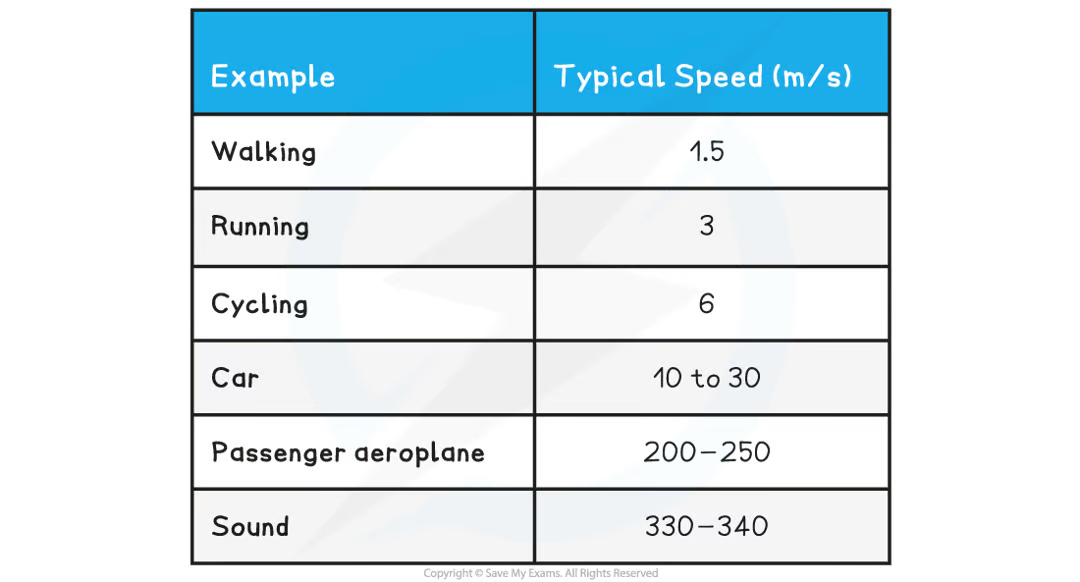
acceleration due to gravity
10 m/s2
typical accelerations table
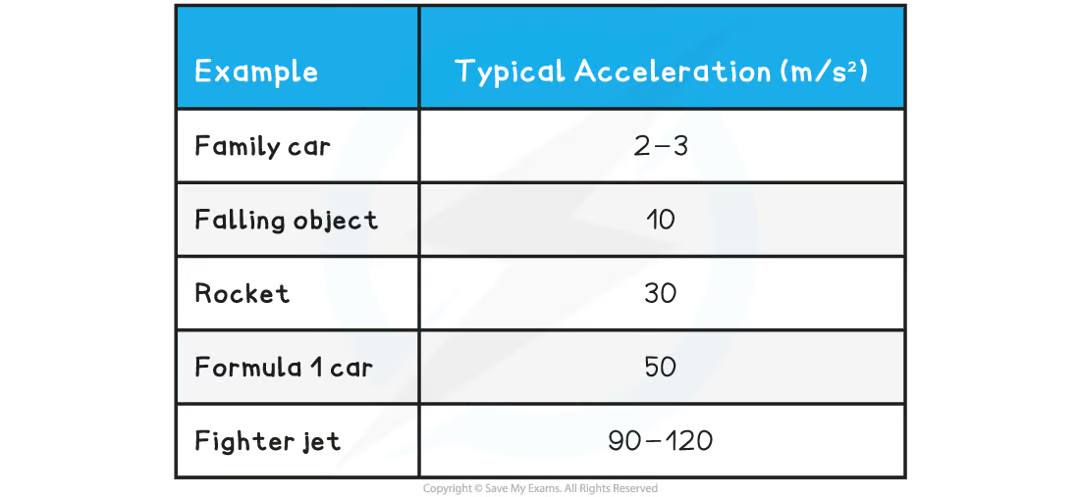
newton’s first law
when the resultant force on a body is zero (still or at a constant speed), it will stay at zero unless an external force acts upon it
when the resultant force on a body is not zero, the object will accelerate, deaccelerate, or change direction
no force = no change in motion // force = change in motion
newton’s second law
force (N) = mass (kg) x acceleration (m/s2)
f = m x a
force = change in momentum (kg m/s) / time (s)
F = (mv - mu)
t
weight definition
the force acting on an object due to gravitational attraction
weight equation
weight (N) = mass (kg) x gravitational field strength (N/kg)
W = m x g
how to measure weight
using a newton-meter, which measures force in newtons. spring fixed at one end with a hook to attach an object on the other
you can indirectly measure weight using a top pan balance (scales) to find mass and then use w=mg
gravitational field strength (g) on earth
10 N/kg
relationship between weight & gravitational field strength
mass always stays the same
weight changes depending on gravity:
if gravity increases, weight increases
if gravity decreases, weight decreases
equipment for investigating acceleration practical
metre ruler: to measure distance
car / trolley: the object for which acceleration is measured
pencil / chalk: to mark intervals of distance
bench pulley & string: to connect masses to the trolley
weights & weight hanger: to provide force on the trolley
stopwatch: to time the trolley between distance intervals
blu tac: to attack extra weight to trolley if needed
independent variable
the variable you change, that is unaffected by other variables
dependent variable
the variable you measure, depends on other variables
control variable
something you keep the same
what happens when an object is moving in a circular orbit at a constant speed
even though speed is constant, the velocity is constantly changing because it depends on direction
centripetal force
The resultant perpendicular force towards the centre of the circle required to keep a body in uniform circular motion
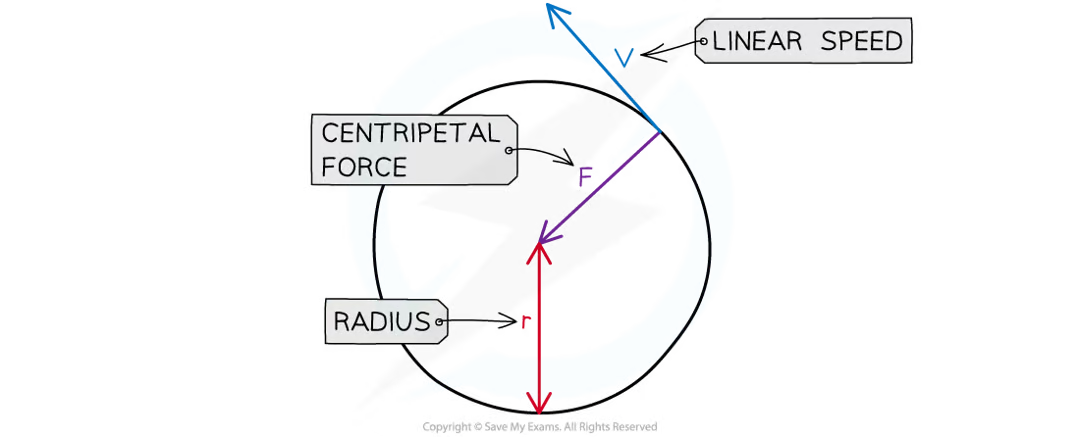
inertial mass
how hard it is to change an object’s velocity (speed or direction), something with a large inertial mass resists acceleration more than one with a small inertial mass
mass = force / acceleration (comes from f = ma)
the more mass an object has, the more it resists changes in velocity
newton’s third law
if object A exerts a force on object B, then object B will exert a force on object A that’s exactly the same size, at exactly the same time, but in the opposite direction
action reaction forces
newton’s third law in equilibrium situation
if an object is at rest or moving at a constant velocity, the forces acting on it are balanced
e.g. for a book on a table, the book pushes down on the table (its weight) and the table pushes up on the book with an equal force (reaction force) meaning nothing moves.
newton’s third law in collisions with momentum conservation
if e.g. two ice skaters push apart, A pushes on B, and B pushes back on A, their combined total momentum before and after is the same
this is because they each have the same momentum but going in opposite directions so together it equals zero
law of conservation of momentum in collisions
total momentum before = total momentum after
momentum definition
how much motion an object has
equation for momentum
momentum (kg m/s) = mass (kg) x velocity (m/s)
p = m x v
elastic collsision
when objects collide and move in opposite directions
each object will have a different velocity depending on its mass and the initial momentum of the system
inelastic collisions
when objects collide and move in the same direction together
objects have a combined velocity
reaction time
how much time passes between seeing something and reacting to it
a reaction time for someone who is alert (waiting to react to something) is between 0.2 and 0.9 seconds
ruler method for measuring reaction time
person a holds a ruler vertically at the top end so that the bottom end hovers over the top of person b’s hand
person a releases the ruler unexpectedly
as soon as person b sees the ruler move, they close their hand to catch it
the ruler is marked at the point at which it was caught by person b
the greater distance, the longer reaction time
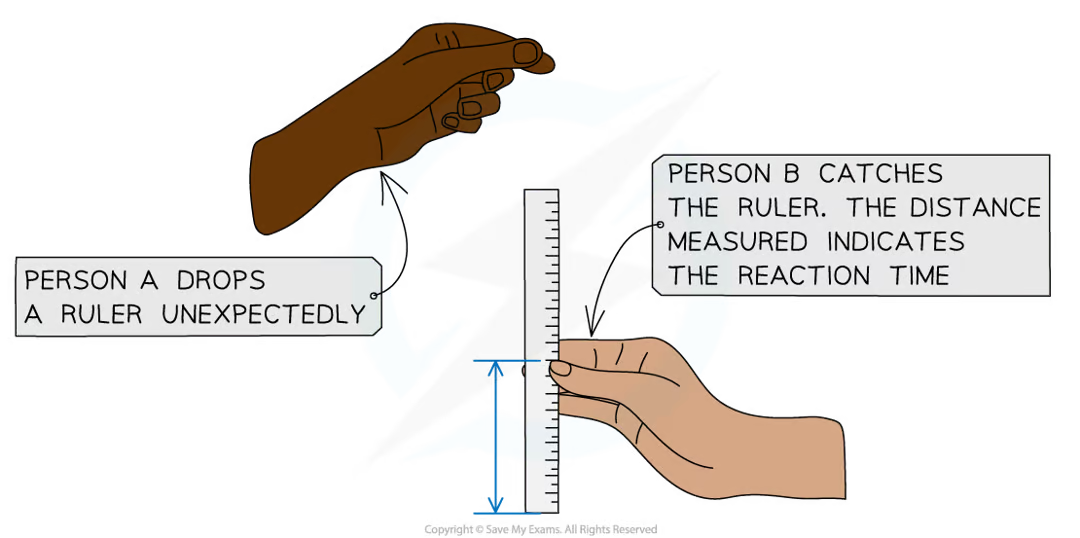
formula of stopping distance of a vehicle
thinking distance + braking distance
thinking distance = distance travelled in the time it takes the driver to react (reaction time) in meters
braking distance = distance travelled under the braking force in meters
the greater the speed of the vehicle, the greater the stopping distance
factors affecting stopping distance of a vehicle
vehicle mass
vehicle speed
driver’s reaction time
state of the brakes
state of the road
friction between the tire and the road (e.g. icy road = less friction)
factors affecting a driver’s reaction time
tiredness
distractions e.g. using a phone
intoxication: alcohol / drugs
dangers of large decelerations
overheating of brakes: kinetic energy of vehicle is converted into thermal energy of the brakes, and if they get too hot they can fail, meaning they won’t work effectively
injury: when a vehicle decelerates the driver & passengers also decelerate and this can cause injuries e.g. whiplash, a neck injury when your head moves suddenly relative to your body
loss of control: it’s more difficult to control a vehicle that’s decelerating, and loss of control can cause a collision
equation for work done
work done (J) = force (N) x distance moved in direction of force (m)
E = F x d
braking distance with kinetic energy & work done
when a vehicle brakes, its kinetic energy is being transferred to thermal energy.
so work is being done on the vehicle by the braking force. the work done = the total kinetic energy transferred to heat
you can calculate braking distance and/or work done and/or braking force using E = F x d:
E = work done = KE
F = braking force
d = braking distance
because work done is the same as kinetic energy, we can say that ½ x m x v² = F x d
equation for change in GPE
change in GPE (J) = mass (kg) x gravitational field strength (n/kg) x change in vertical height (m)
ΔGPE = m x g x Δh
kinetic energy equation
kinetic energy (J) = ½ x mass (kg) x speed2 (m/s)
KE = ½ x m x v2
sankey diagrams
sankey diagrams show the amount of energy transferred and where to
different thicknesses of arrows represent how much energy is transferred in that way
percentages are put in brackets
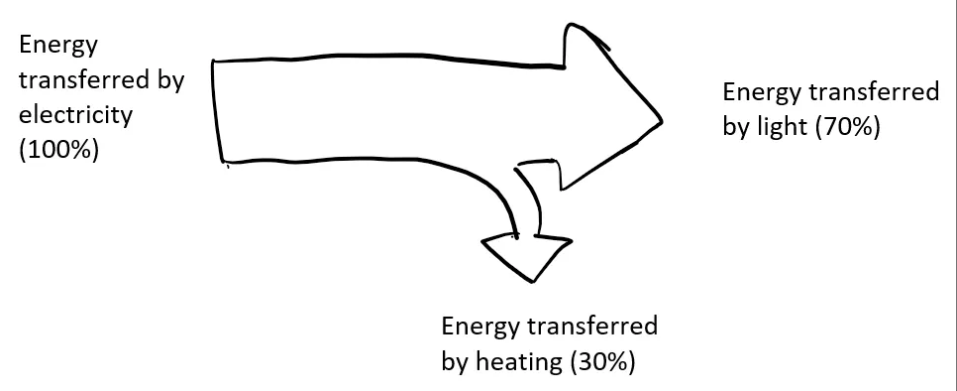
other energy transfer diagrams

principle of conservation of energy
energy can’t be created or destroyed, it can only be transferred from one store to another
so the total amount of energy in a closed system remains constant
the total energy transferred into a system must be equal to the total energy transferred out
energy transferred when a ball being thrown up
before ball is thrown the person holding the ball has energy in their chemical store
when the ball is thrown some of that energy is transferred to the kinetic store of the ball as it begins to move upwards
as the height of the ball increases, energy from the kinetic store of the ball is transferred to its gravitational potential store
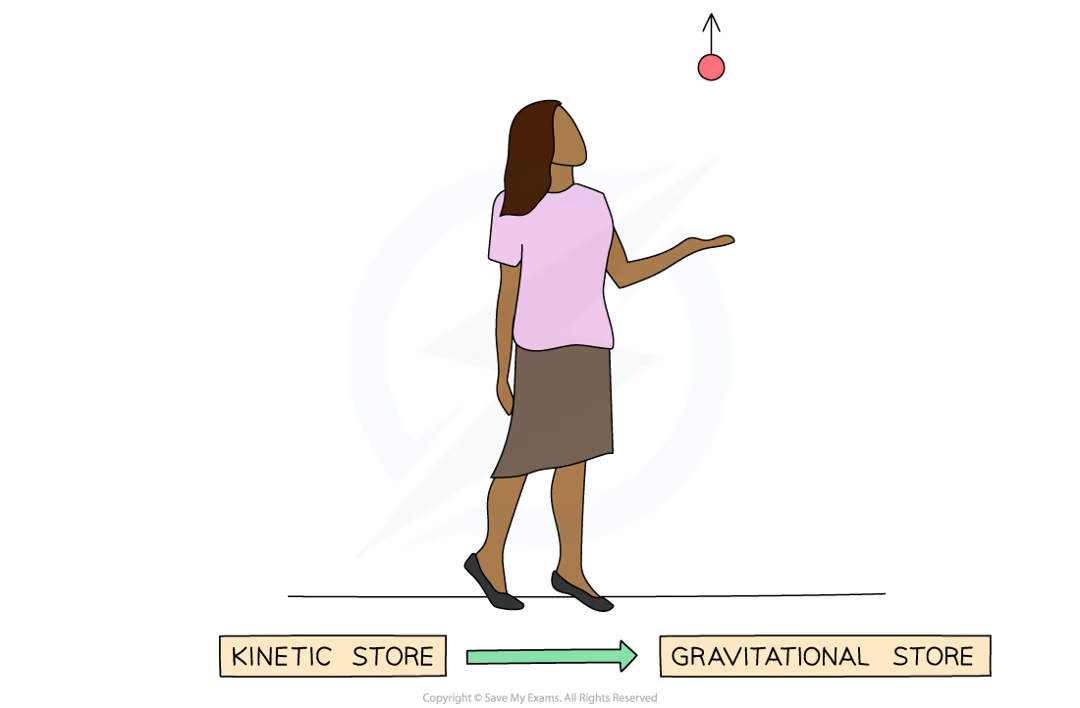
energy transfers with a moving object hitting an obstacle
when a car is moving energy in the chemical store of fuel is transferred to the kinetic store
when it hits a wall the speed and therefore the energy in the kinetic store decreases quickly
most of this energy is dissipated
but some is transferred mechanically to the thermal store of the wall (the force of the car on the wall)
and some is transferred by heating to the thermal store of the air as the sound waves transfer energy away from the system
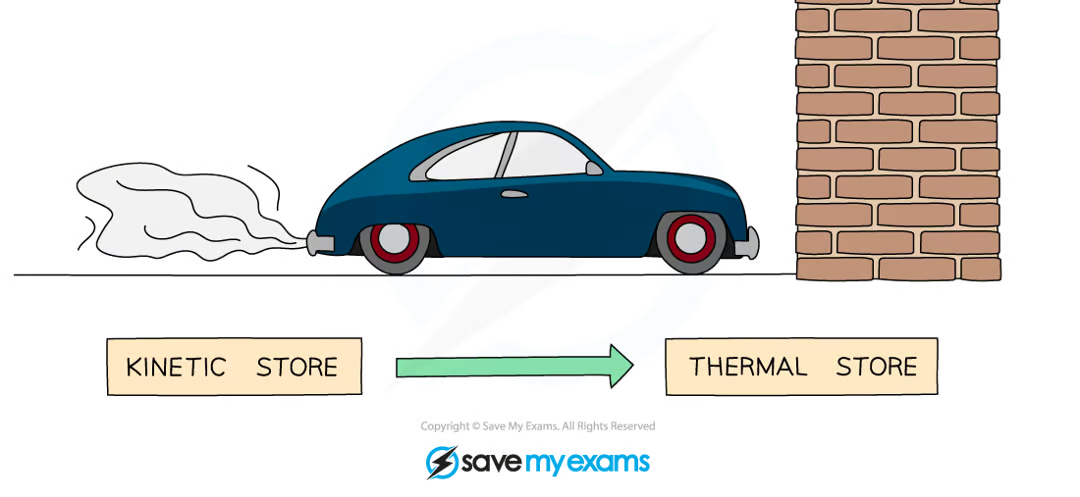
energy transfers with a vehicle being accelerated by a constant force
when the vehicle is stationary it has energy in the chemical store of its fuel
when it accelerates, the energy is transferred to the kinetic store of the car
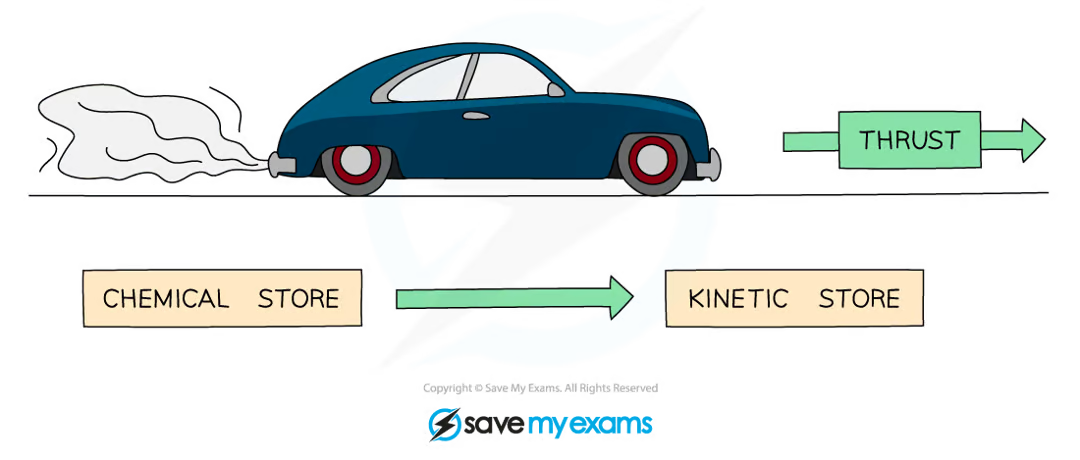
energy transfers with a vehicle slowing down
the moving vehicle has energy in its kinetic store
as it slows energy is transferred to the thermal store of the surroundings (dissipated)
energy is also transferred by heating due to friction between the tyres and the ground and the the brakes and the brake pads
energy is transferred by heating as sound waves transfer energy away from the system
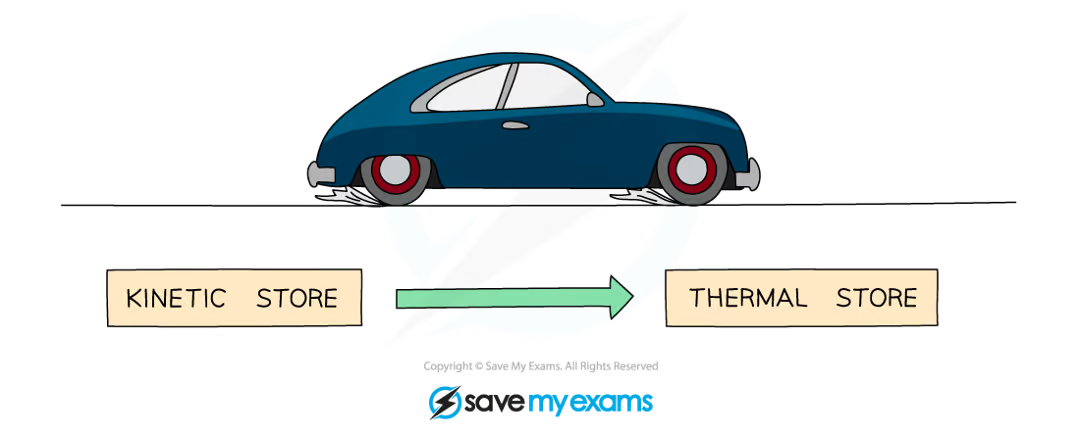
energy transfers with boiling water in an electric kettle
energy is transferred electrically from the mains supply to the thermal store of the heating element in the kettle
as the heating element gets hotter energy is transferred by heating to the thermal store of the water

energy transfers with a trampoline
elastic potential energy → kinetic energy → gravitational potential energy
while jumping the person has energy in their kinetic store
when the person lands on the trampoline most of that energy is transferred to the elastic potential store of the trampoline
that energy is transferred back to the kinetic store of the person as they bounce up
as the person gains height energy is transferred from kinetic → gravitational potential
some of the energy is dissipated by heating to the thermal store of the surroundings (person, trampoline, air)
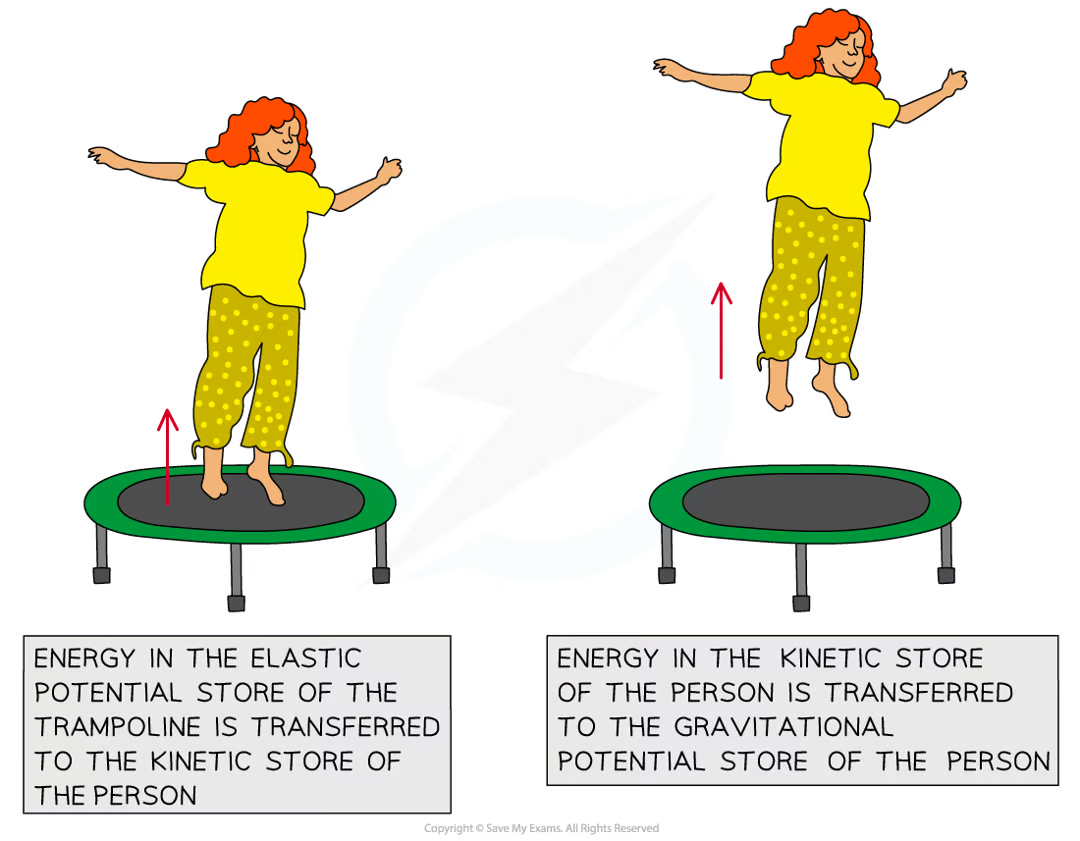
how do mechanical processes become wasteful (energy)
when they cause a rise in temperature (usually through friction) because energy dissipates through heating into the surroundings
useful energy definition
an energy transfer that serves an intended purpose
wasted energy definition
an energy transfer that is not useful for the intended purpose and is dissipated to the surroundings
dissipated energy
energy that spreads out into the surroundings is hard to ‘gather’ so that it can be used usefully again. this means that the energy becomes less useful
whenever a process produces unwanted heating, light, or sound, the energy is dissipated and wasted
however not all dissipated energy is wasted e.g. a tv generates light & sound energy that is useful, or a heater generates useful heat energy
reducing energy loss
producing lots of waste energy can take up lots of energy and be very expensive, so we need to find ways to reduce waste
lubrication and insulation
Insulation
reduces energy lost from conduction
effectiveness depends on:
thermal conductivity (must be low)
density of material (must be low)
thickness of material (must be high)
insulation is made of fibreglass / glass fibre, a reinforced plastic composed of woven matieral with glass fibres laid across and held together. the air trapped between the fibres makes it a good insulator
cavity wall insulation: gaps (cavities) between external walls are filled with insulation (a special type of foam) to lower conduction from inside to outside
thermal conductivity
how well a material allows heat to move through it
depends on thickness and temperature across the material
a good insulator needs low thermal conductivity
three ways in which energy is transferred through heating
conduction: vibrations passed between particles in a solid
convection: part of a fluid is warmer (less dense) and rises up, on the other side the colder (more dense) fluid sinks, creating a convection current going around in a circle
radiation: energy transferred through waves. infrared radiation can pass through some solid objects. works in a vacuum
lubrication
friction is a major cause of wasted energy transfers, and the amount of wasted energy can be reduced if the amount of friction is reduced. this is done by lubricating the parts that rub together
efficiency equation
useful energy transferred by device / total energy supplied to device
how to improve efficiency of a device
by reducing wasted energy transfers due to friction, air resistance, electrical resistance, or noise
reducing friction
adding bearings to prevent components from directly rubbing together
lubricating parts
reducing electrical resistance
in electrical circuits there is resistance as current flows through the wires and components, resulting in unwanted energy transfers by heating to the wires, components & surroundings
this can be reduced by using components with lower resistance or reducing the current
reducing air resistance
air resistance causes frictional force between the moving object and the air that opposes its motion, resulting in unwanted energy transfers by heating to the object and the surroundings
this can be reduced by streamlining the shapes of moving objects
e.g. cyclists adopt more streamlined posture to reduce the effects of air resistance. their bicycle, clothing, and helmet are streamlined too
reducing noise
sound is created by moving parts of machinery, resulting in unwanted energy transfers by heating to the surroundings as sound waves cause the particles in the air & nearby objects to vibrate
this can be reduced by tightening loose parts to reduce vibration or lubricating parts
energy resources: solar energy
heating & lighting from the sun are either used with solar cells to generate electricity, or radiation from the sun is used to heat water for homes using solar panels
energy resources: wind energy
using wind turbines we can use the kinetic energy of the wind to turn a turbine and generate electricity
energy resources: hydroelectric energy
water flowing in a river turns a turbine to generate electricity. we usually need to build a dam and let water flow through it gradually
energy resources: wave energy
the sea’s waves have kinetic energy and using machines we can turn that into electricity
energy resources: nuclear energy
the energy in uranium nuclei is transferred into heating, which is used to create steam that turns a turbine and generates energy
nuclear store of fuel → thermal store of water → kinetic store of turbine → kinetic store of generator
energy resources: fossil fuels
chemical energy in coal, oil, and gas is transferred into heating, which is used to create steam which turns a turbine and generates electricity
energy in chemical store of fuel → thermal store of water → kinetic store of turbine → kinetic store of generator → transferred electrically to national grid
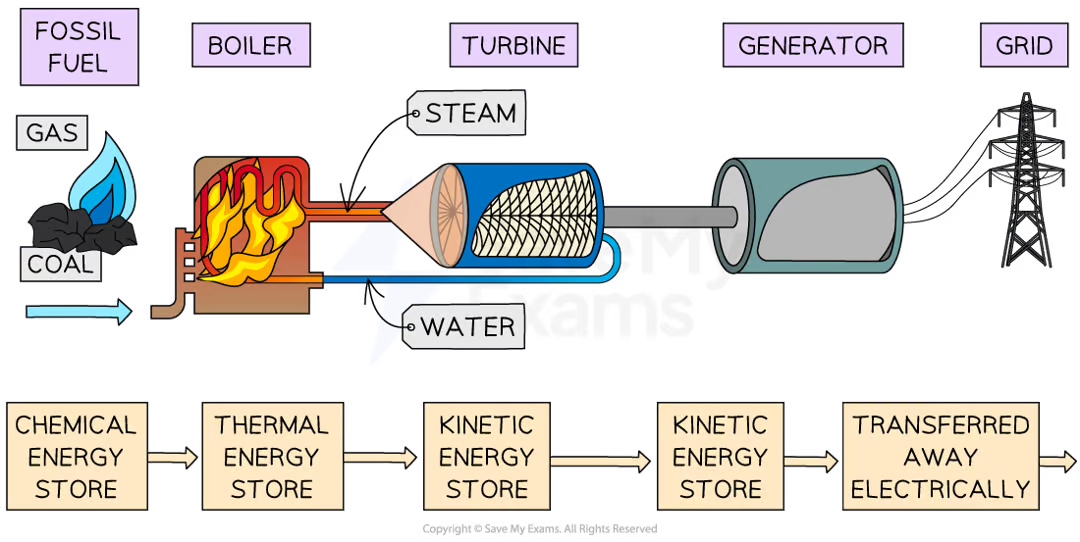
energy resources: biomass energy
chemical energy in things that were once alive e.g. trees is transferred to heating when they are burned
energy resources: geothermal energy
rocks deep underground are very hot, and we can use this heat to generate electricity by producing steam to turn a turbine

energy resources: tidal energy
at high tide, water is trapped behind a dam, and at low tide it is released, turning turbine which is used to generate electricity
energy resources
energy resources: large stores of energy that can be used to generate electricity and heat homes & businesses
can be renewable or non-renewable
in most cases a turbine is turned, which turns a generator, which generates energy. what changes is how the turbine is made to turn
renewable energy resources
an energy resource that is replenished at a faster rate than the rate at which it is being used. as a result of this it won’t run out
solar energy
wind
biofuel/biomass
hydroelectricity
geothermal
tidal
wave
non-renewable energy resources
fossil fuels (coal, oil, natural gas) and nuclear fuel
reliable energy resource
one that can product energy at any time
non-reliable ones can only produce energy some of the time e.g. when its windy / when its sunny
energy resources advantages & disadvantages
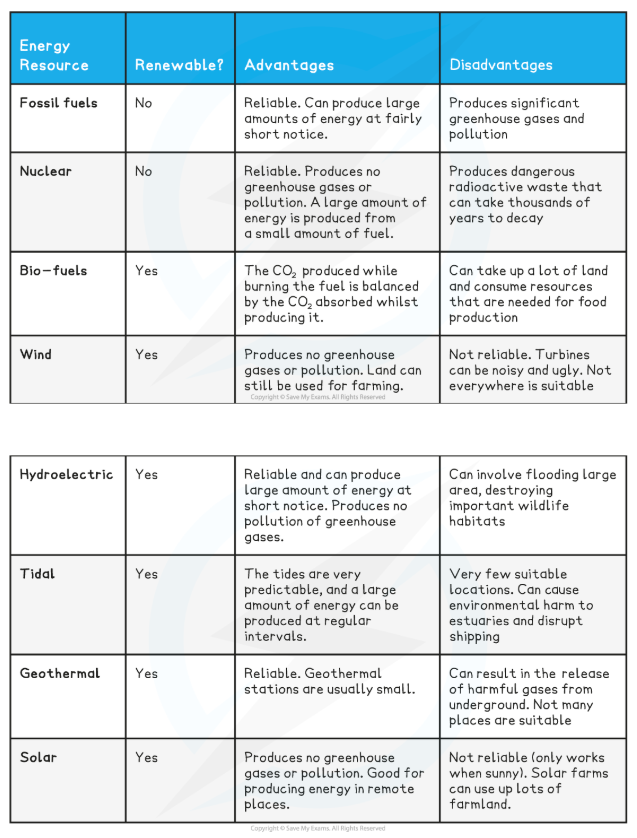
three main uses of energy resources
transport
electricity generation
heating
use of energy resources: transport
most vehicles are powered by petroleum products (e.g. petrol, diesel, kerosene) which originate from crude oil, a fossil fuel
but more vehicles now are being powered by electricity, which produces no carbon emissions but uses both renewable and non-renewable energy sources
vehicles can also be powered by biofuel, which is a renewable resource but some believe that the process isn’t carbon-neutral
use of energy resources: electricity
increasing population + increasing use of electricity = high electricity demand
this means that all available energy resources are needed for electricity generation, however the majority of this is non-renewable & carbon-emitting. this has a negative effect on the environment
use of energy resources: heating
central heating systems utilise natural gas to heat up water which can be pumped around radiators, but gas isn’t renewable
some geologically active countries (e.g. Iceland) can heat their homes using geothermal energy
waves
an oscillation (vibration) that transfers energy, not matter, from one place to another
wavelength
the distance from one point on the wave to the same point on the next wave aka the length of one cycle e.g. from crest to crest or trough to trough
symbol λ (lambda)
measured in meters
amplitude
the size of the wave, ½ of the crest to trough in meters, symbol A
frequency
the number of complete waves to pass a point per second in hertz (Hz)